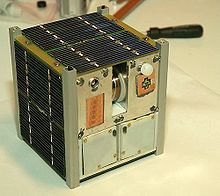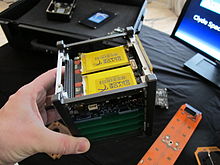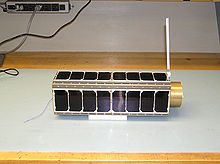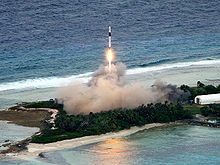- CubeSat
-
For more information, see List of CubeSats.
 Ncube-2, a Norwegian Cubesat.
Ncube-2, a Norwegian Cubesat.
A CubeSat is a type of miniaturized satellite for space research that usually has a volume of exactly one liter (10 cm cube), has a mass of no more than 1.33 kilograms,[1] and typically uses commercial off-the-shelf electronics components. Beginning in 1999, California Polytechnic State University (Cal Poly) and Stanford University developed the CubeSat specifications to help universities worldwide to perform space science and exploration.
The majority of development comes from academia, but several companies have built CubeSats, including large-satellite-maker Boeing. The CubeSat format is also popular with amateur radio satellite builders.
Contents
Philosophy
The CubeSat specification accomplishes several high-level goals
- Simplification of satellite infrastructure: Makes it possible to design and produce a workable satellite at low cost.
- Encapsulation of launcher-payload interface: Takes away the prohibitive amount of managerial work that would previously be required for mating a piggyback satellite with its launcher.
- Unification among payloads and launchers: This enables quick exchanges of payloads and utilization of launch opportunities on short notice.
Design
The term "CubeSat" was coined to denote nano-satellites that adhere to the standards described in the CubeSat design specification. Cal Poly published the standard in an effort led by aerospace engineering professor Jordi Puig-Suari.[2] Bob Twiggs, from the Department of Aeronautics & Astronautics at Stanford University, and currently on the space science faculty at Morehead State University in Kentucky,[3] has contributed to the CubeSat community. His efforts have focused on CubeSats from educational institutions.[4] The specification does not apply to other cube-like nano-satellites such as the NASA "MEPSI" nano-satellite, which is slightly larger than a CubeSat.
In 2004, with their relatively small size, CubeSats could each be made and launched for an estimated $65,000–$80,000.[2] This price tag, far lower than most satellite launches, has made CubeSat a viable option for schools and universities across the world. Because of this, a large number of universities and some companies and government organizations around the world are developing CubeSats — between 40 and 50 universities were developing CubeSats in 2004, Cal Poly reported.[2]
The standard 10×10×10 cm basic CubeSat is often called a "1U" CubeSat meaning one unit. CubeSats are scalable along only one axis, by 1U increments. CubeSats such as a “2U” CubeSat (20×10×10 cm) and a “3U” CubeSat (30×10×10 cm) have been both built and launched.
Since CubeSats are all 10x10 cm (regardless of length) they can all be launched and deployed using a common deployment system. CubeSats are typically launched and deployed from a mechanism called a Poly-PicoSatellite Orbital Deployer (P-POD), also developed and built by Cal Poly.[5] P-PODs are mounted to a launch vehicle and carry CubeSats into orbit and deploy them once the proper signal is received from the launch vehicle. P-PODs have deployed over 90% of all CubeSats launched to date (including un-successful launches), and 100% of all CubeSats launched since 2006. The P-POD Mk III has capacity for three 1U CubeSats however, since three 1U CubeSats are exactly the same size as one 3U CubeSat, and two 1U CubeSats are the same size as one 2U CubeSat, the P-POD can deploy 1U, 2U, or 3U CubeSats in any combination up to a maximum volume of 3U.[6]
CubeSat forms a cost-effective independent means of getting a payload into orbit.[2] Most CubeSats carry one or two scientific instruments as their primary mission payload. Several companies and research institutes offer regular launch opportunities in clusters of several cubes. ISC Kosmotras and Eurokot are two companies that offer such services.[7]
Successful projects
One of the earliest launches of CubeSats was 30 June 2003 from Plesetsk, Russia, with Eurockot Launch Services's Multiple Orbit Mission. CubeSats were put into a sun-synchronous orbit and included the Danish AAU CubeSat and DTUSat, the Japanese CubeSat XI-IV and CUTE-1, the Canadian Can X-1, and the US triple-CubeSat Quakesat.[8]
On 27 October 2005, a Kosmos-3M launch vehicle launched from Plesetsk carried three CubeSats into orbit on the European Space Agency's Student Space Exploration & Technology Initiative (SSETI) mission. The SSETI Express Satellite student-built satellite was not a CubeSat as it weighed 136 pounds and was the size of a washing machine.[9] The CubeSats that did make orbit on this launch were the Ncube satellite project from the Norwegian University of Science and Technology and the University of Tokyo's CubeSat XI-V.[9]
Seven CubeSats were launched 17 April 2007 as secondary payloads on a Dnepr rocket.[10] They included a Colombian project from the students at the Universidad Sergio Arboleda. Their satellite, called Libertad 1, was Colombia's first. The Aerospace Corporation had their AeroCube 2,[11] CP-3 & CP-4 were on board from California Polytechnic State University,[12] and CAPE-1 from the University of Louisiana at Lafayette.
In a launch coordinated by the Nanosatellite Launch System, a Polar Satellite Launch Vehicle launched CubeSats on April 28, 2008. One was a 3-unit CubeSat (10x10x30 centimeters) named Delfi-C3 from Delft University of Technology in the Netherlands.[13]
On December 8, 2010, several CubeSats were reported to have deployed successfully from a SpaceX Falcon 9 rocket, the same one that launched their first Dragon spacecraft on COTS Demo Flight 1.
Applications
Development of CubeSat technology
- AAU CubeSat, by Aalborg University – The Danish students in this project, beginning in the summer of 2001, designed a satellite that would evaluate the technology and demonstrate the capabilities of the CubeSat concept. In order to successfully show the technology to the public, the team installed a camera on board the spacecraft, and outfitted it with a magnetically-based attitude control system. But upon reaching orbit, the radio signals were weaker than expected and the batteries failed after only one month of semi-operational activity.[14]
- AAUSAT-II is the second student-built CubeSat built and operated by students from Aalborg University in Denmark. It was launched 28 April 2008 05:54 UTC from Satish Dhawan Space Centre in India on a PSLV rocket. AAUSAT-II carries a radiation sensor.
- AAUSAT3 is the third student-built CubeSat from Aalborg University in Denmark. The primary payload is an AIS receiver which primary task is to receive AIS data from ships around Greenland. Planned launch Q1 2011.
- PW-Sat, by Warsaw University of Technology – This experiment revolves around CubeSats themselves. The test will involve developing a method to deorbit CubeSats by engaging an atmospheric drag device.[15] The mission's focus will be the testing of this foil device; its deployment to intentionally bring the satellite back into the thicker portion of Earth's atmosphere to bring the mission to an end.[16] If successful the satellite will be Poland's first.[17]
- OUFTI-1, by the University of Liège and I.S.I.L (Haute École de la Province de Liège) – This is a 1-unit CubeSat that is being built by Belgian students. The name is an acronym for Orbital Utility For Telecommunication Innovation. The Belgian satellite is scheduled to launch on the maiden flight of Vega. The goal of the project is to develop experience in the different aspects of satellite design and operation. In the communications portion of the device, the academic team will be experimenting with the D-STAR digital voice mode and communications protocol that is popular with amateur radio operators.[15][18] The satellite has a mass of just 1 kilogram and will utilize a UHF uplink and a VHF downlink.[19]
- CubeSat TestBed 1, by Boeing – Boeing successfully completed all of its design and operational goals with its first nanosatellite. It was built and flown to explore the possibilities with the new CubeSat standard.[20] Boeing satellites are usually much larger; a Boeing 601 or 702 satellite has 1,000 times the mass of their 1 kilogram CubeSat.[21]
- InnoSAT, by Astronautic Technology Sdn Bhd – This CubeSat will test attitude control and navigation technologies developed by five Malaysian universities.[22]
- XSAS, by University of Michigan – This project, based on graduate research, will house an accordion folded solar array inside a 1U CubeSat. The array will extend into a long solar panel once in orbit, thereby increasing by many times the power available to an attached CubeSat.[23]
Earth remote sensing
For more details on this topic, see Earth remote sensing.- Quakesat, by Quakefinder – This satellite was set out on a mission to help scientists improve earthquake detection. The students are hoping that the detection of magnetic signals may have value in showing the onset of an earthquake.[24] The company that put the satellites together is from Palo Alto, California. They're gathering data on the extremely low magnetic field fluctuations that are associated with earthquakes to help better understand this area of study that has its skeptics.[25] The 30 June 2003 deployment of Quakesat was alongside other university CubeSats and one commercial CubeSat. The launch occurred on a Rockot rocket from Russia’s Plesetsk launch site.
- SwissCube, by École Polytechnique Fédérale de Lausanne – This project has been selected to fly aboard a new expendable launch system being developed for Arianespace jointly by the Italian Space Agency and the European Space Agency. The rocket is called Vega, and takes its name from the star. The Swiss students will conduct experiments with the air glow phenomenon in the Earth's atmosphere.[15] The satellite's downlink radio will transmit at 437 MHz; the uplink will be at 145 MHz.
- PLUME, by the University of Leicester – They plan to launch a CubeSat that will detect cosmic dust, and will be the first English CubeSat to be launched.[26] The students began their project at the beginning of 2007 and if successful will have a method for scientists to look at the smallest ever dust particles from space.[27] They are publishing their documentation and code freely via a wiki.[28]
- Firefly, by NASA's Goddard Space Flight Center and Siena College – Terrestrial gamma-ray flashes have been detected from the Compton Gamma Ray Observatory after its launch in 1991. Scientists have theories about their origins and this new CubeSat will have instruments that will observe both photons and electrons simultaneously. This, in turn, will allow scientists to better determine if lightning is the source of the gamma-ray bursts.[29]
Space tether
For more details on this topic, see Tether satellite.- MAST, by Tethers Unlimited – The Multi-Application Survivable Tether experiment, based in the United States, was launched 17 April 2007 aboard a Dnepr rocket. This 1 km multistrand, interconnected tether (Hoytether) is being used to test and prove the long-term survivability for tethers in space. The three MAST pico-satellites ejected from the P-POD successfully, but the separation mechanism did not function properly, preventing full deployment of the tether. Nonetheless, the experiment operated for over a month and downloaded over 2 MB of data on tethered satellite dynamics as well as images of the tether.[30] While Stanford University formed the academic portion of the team, Tethers Unlimited, from Seattle, Washington, formed the commercial portion of the team.[31]
- Tempo3, by The Mars Society – This operation is called the Tethered Experiment for Mars inter-Planetary Operations and is meant to demonstrate the generation of artificial gravity. The project seeks to enhance knowledge about long term space flight.[32]
Biology
- GeneSat 1, by the NASA Ames Research Center – In December 2006, a Minotaur launch vehicle carried this satellite into orbit from NASA's Wallops Flight Facility to carry out a genetics experiment. The team assembled the biological growth and analysis systems to perform experiments with E. coli bacteria.[33] The project is not cheap by CubeSat standards: the total spent on the satellite and its experiments were $6 million before the launch took place. The goal is to establish methods for studying the genetic changes that come from being exposed to a space environment.[34] The satellite was outfitted with a UHF beacon.
Other
- StudSat, first Indian satellite of Pico-Category was developed by a group of 50 under graduate students at Nitte Meenakshi Institute of Technology, Bangalore, India, and was launched 12 July 2010 by Polar Satellite Launch Vehicle.[citation needed][dated info]
- Cubesat ROBUSTA, by Montpellier 2 University – A mission to test the effects of radiation on electronics.[15] The goal is to specifically check the deterioration of electronic components based on bipolar transistors when exposed to the space radiation environment. The results of this experiment will be used to validate a test method proposed in the laboratory. The French satellite is scheduled to launch on the maiden flight of Vega.
- TJ³Sat, by Thomas Jefferson High School for Science and Technology, Alexandria, Va., which aims to be the first CubeSat by high school students.[35]
- Xatcobeo, by University of Vigo and Instituto Nacional de Técnica Aeroespacial – The goal for this project is to test software defined radio and to experiment with solar panel deployment.[15] The Spanish satellite is scheduled to launch on the maiden flight of Vega.[when?][15]
- CINEMA, a collaborative effort between the UC Berkeley Space Sciences Laboratory, Imperial College London, Kyung Hee University, and the Interamerican University of Puerto Rico. The project's goal is to develop a cubesat that monitors space weather using a combination of magnetometers and particle detectors.[36]
Launch failures
Dnepr
On 26 July 2006, 14 CubeSats from 11 universities and a private company were launched aboard a Dnepr rocket, the largest planned deployment of CubeSats to date.[4] The rocket failed and was destroyed during launch, obliterating the CubeSats and four other satellites aboard.[38] The launch was lost after the first stage engine shut down prematurely.[39] All satellite parts are believed destroyed.
The committee investigating the failed launch concluded that the failure was caused by a malfunctioning hydraulic drive unit on the rocket's first stage.[40] The control malfunctioning brought about the disturbances, which led to the roll instability, excessive dispersions of the yaw and pitch angles. Thrust termination occurred at 74 seconds after lift off.
The launch had been postponed numerous times because the primary payload, EgyptSat 1, was not ready. Due to ITAR concerns,[citation needed] the CubeSats were moved to a different launch site, with the primary payload being BelKA, which was to be the first satellite from Belarus.
The launch carried Rincon 1 and SACRED, both from the University of Arizona. Other projects came from the Norwegian University of Science and Technology, Hankuk Aviation University, Seoul, Korea and Polytechnic University of Turin, Italy. The Aerospace Corporation, from the United States, also had its own commercial project onboard.
Falcon 1
On 3 August 2008, a SpaceX Falcon 1 launched from the Kwajalein Atoll launch facility (US) with two NASA CubeSats. They were the PREsat from NASA's Ames Research Center, and the NanoSail-D from both NASA's Marshall Space Flight Center and Ames Research Center.[41] These CubeSats were lost due to a launch vehicle failure when the rocket's first stage inadvertently made contact with the second stage after separation. The ground spare for NanoSail, the NanoSail-D2 cubesat, was successfully launched in November 2010 and deployed from the FASTSAT satellite on a Minotaur IV launch.
Planned projects
NASA Educational Launch of Nanosatellites
A February 23, 2011, launch (setback from a November 2010 launch date due to delays) was scheduled for three university CubeSats to be launched by NASA in their mission called ELaNa (Educational Launch of Nanosatellites).[42] These university satellites include the Space Science and Engineering Laboratory's Explorer-1 PRIME (E1P) developed by students at Montana State University, Kentucky Space's KySat-1 which was developed by multiple Kentucky universities plus several organizations and companies,[43] and the University of Colorado-Boulder's HERMES. The backup for the launch is University of Florida's ASTREC-1.[44] The satellites were lost when the Glory satellite launch failed 5 minutes after take off.
Another example of one of the ELaNa satellites is the University of New Mexico's Space Plug-and-play Architecture (SPA) proof of concept flight for the Trailblazer mission. Trailblazer is a 1U Cubesat to be launched in 2012 under the ELaNa four mission.[45]
QB50
The goal of the QB50 project is to use an international network of 50 CubeSats for multi-point, in-situ measurements in the lower thermosphere (90–300 km) and re-entry research. QB50 is an iniative of the Von Karman Institute, ESA and NASA. Double-unit CubeSats (10x10x20 cm) are foreseen, with one unit (the 'functional' unit) providing the usual satellite functions and the other unit (the 'science' unit) accommodating a set of standardised sensors for lower thermosphere and re-entry research. 35 CubeSats are envisaged to be provided by universities in 19 European countries, 10 by universities in the US, 2 by universities in Canada and 3 by Japanese universities. All 50 CubeSats will be launched together on a single launch vehicle, a Russian Shtil-2.1. The launch is planned for mid 2013.[46]
Releasing CubeSats from International Space Station
JAXA is planning to release CubeSats from the International Space Station using the Japanese Experiment Module's robot hand.[47] RAIKO by Wakayama University, FITSAT-1 by Fukuoka Institute of Technology, and WE WISH by Meisei Electric were selected to be launched in September 2012.[48]
See also
- List of CubeSats
- AMSAT
- Canadian Advanced Nanospace eXperiment Program
- Israeli Nano Satellite Association
- OSCAR
- UCISAT
- Cubesat Space Protocol
References
- ^ "CubeSat Design Specification Rev. 12". California State Polytechnic University. http://www.cubesat.org/images/developers/cds_rev12.pdf. Retrieved 2010-10-16.
- ^ a b c d Leonard David (2004). "Cubesats: Tiny Spacecraft, Huge Payoffs". Space.com. http://www.space.com/businesstechnology/cube_sats_040908.html. Retrieved 2008-12-07.
- ^ Rob Goldsmith (October 6, 2009). "Satellite pioneer joins Morehead State's space science faculty". Space Fellowship. http://spacefellowship.com/news/art14006/satellite-pioneer-joins-morehead-state-s-space-science-faculty.html. Retrieved 2010-09-20.
- ^ a b Leonard David (2006). "CubeSat losses spur new development". Space.com. http://www.cnn.com/2006/TECH/space/08/30/cloudsat/index.html. Retrieved 2008-12-11.
- ^ "Educational Payload on the Vega Maiden Flight – Call For CubeSat Proposals". European Space Agency. 2008. http://esamultimedia.esa.int/docs/LEX-EC/CubeSat_CFP_issue_1_rev_1.pdf. Retrieved 2008-12-07.
- ^ Matthew Richard Crook (2009). "NPS CubeSat Launcher Design, Process And Requirements". Naval Postgraduate School. http://www.dtic.mil/cgi-bin/GetTRDoc?AD=ADA501503&Location=U2&doc=GetTRDoc.pdf. Retrieved 2009-12-30.
- ^ Jos Heyman (2009). "FOCUS: CubeSats — A Costing + Pricing Challenge". SatMagazine. http://www.satmagazine.com/cgi-bin/display_article.cgi?number=602922274. Retrieved 2009-12-30.
- ^ "EUROCKOT Successfully Launches MOM – Rockot hits different Orbits". Eurockot Launch Services. http://www.eurockot.com/alist.asp?cnt=20040706&main=5. Retrieved 2010-07-26.
- ^ a b Tariq Malik (2005). "Europe's Student-Built Satellite Rockets into Space". Space.com. http://www.space.com/missionlaunches/051027_sseti_kosmos_launch.html. Retrieved 2010-07-30.
- ^ "Dnepr LV with 14 satellites on board launched". Space Fellowship. 2007. http://spacefellowship.com/News/?p=2181. Retrieved 2008-12-04.
- ^ Jonathan Brown; Riki Munakata (2008). "Dnepr 2 Satellite Identification and the Mk.III P-POD". California Polytechnic State University. http://mstl.atl.calpoly.edu/~bklofas/Presentations/DevelopersWorkshop2008/session4/5-Dnepr2-Riki_Munakata.pdf. Retrieved 2010-07-30.
- ^ "The ARRL Letter". American Radio Relay League. 2007. http://www.arrl.org/arrlletter?issue=2007-04-06. Retrieved 2010-07-30.
- ^ "Delfi-C3 delivered to launch site". Space Fellowship. 2008. http://spacefellowship.com/News/?p=5072#more-5072. Retrieved 2008-12-24.
- ^ Lars Alminde, Morten Bisgaard, Dennis Vinther, Tor Viscor, Kasper Ostergard (2003). Educational Value and Lessons Learned from the AAU-Cubesat Project. Institute of Electrical and Electronics Engineers. ISBN 0-7803-8142-4. http://vbn.aau.dk/fbspretrieve/168186/fulltext
- ^ a b c d e f "SA Announces Vega CubeSat Selection". European Space Agency. 2008. Archived from the original on 2008-07-18. http://web.archive.org/web/20080718231058/http://www.esa.int/esaED/SEM2BPUG3HF_index_0.html. Retrieved 2008-12-05.
- ^ Piotr Wolański (2008). "Space-related activities at the Warsaw University of Technology and Institute of Aviation". Warsaw University of Technology. http://www.kpk.gov.pl/pliki/9030/Piotr%20Wolanski.pdf. Retrieved 2008-12-07.
- ^ "From the Publisher". Warsaw Voice. 2008. http://www.warsawvoice.pl/printArticle.php?a=18697. Retrieved 2008-12-07.
- ^ "The ARRL Letter". American Radio Relay League. 2008. http://www.arrl.org/arrlletter/08/0404/. Retrieved 2008.
- ^ Steven Ford, WB8IMY (September 2009). A D-STAR repeater in space. QST
- ^ Robert Villanueva (2007). "Boeing Successfully Completes CubeSat Mission to Advance Nano-Satellite Technology". Boeing. http://www.boeing.com/ids/news/2007/q3/070816a_nr.html. Retrieved 2008-12-09.[dead link]
- ^ Elaine Caday-Eames (October 2006). "Small box, big potential". Boeing Frontiers. http://www.boeing.com/news/frontiers/archive/2006/october/i_ids02.pdf. Retrieved 2008-12-09.
- ^ Mr. Kamaruhzaman Mat Zin; Anita Bahari, Nor Rokiah Alias (2009). Breaking New Scientific Frontiers. Ministry of Science, Technology and Innovation (Malaysia). http://www.mastic.gov.my/portals/mastic/publications/warta/Insights2008/vol7.pdf. Retrieved 2010-07-26
- ^ Patrick Senatore; Andrew Klesh, Thomas H. Zurbuchen, Darren McKague, and James Cutler (2010). "Concept, Design, and Prototyping of XSAS: A High Power Extendable Solar Array for CubeSat Applications". University of Michigan Student Space Systems Fabrication Laboratory. http://ntrs.nasa.gov/archive/nasa/casi.ntrs.nasa.gov/20100021926_2010023814.pdf. Retrieved 2010-07-26.
- ^ Tariq Malik (2003). "What's Shakin'? Tiny Satellite to Try and Predict Earthquakes". Space.com. http://www.space.com/businesstechnology/technology/quakesat_detection_030423.html. Retrieved 2008-12-08.
- ^ Leonard David (2003). "Cubesats: On the Prowl for Earthquake Clues". Space.com. http://www.space.com/astronotes/astronotes_june22_july5_03.html. Retrieved 2008-12-05.
- ^ "Students prepare for dust-up – in space!" (Press release). University of Leicester. 2008-06-10. http://www2.le.ac.uk/ebulletin/news/press-releases/2000-2009/2008/06/nparticle.2008-06-10.5844510021. Retrieved 2008-12-05.
- ^ "Student satellite to be launched". BBC News. 2008-06-13. http://news.bbc.co.uk/1/hi/england/leicestershire/7453497.stm. Retrieved 2008-12-07.
- ^ http://cubesat.wikidot.com/
- ^ Irene Klotz (2008). "Probe seeks relationship between lighting strikes, gamma ray flashes". The Discovery Channel. http://www.msnbc.msn.com/id/27892343/. Retrieved 2008-12-07.
- ^ Kelly Young (2007). "Experimental space tether fails to deploy". New Scientist. http://www.newscientist.com/article/dn11836. Retrieved 2008-12-05.
- ^ "Multi-Application Survivable Tether (MAST) Experiment". NASA. 2002. http://sbir.nasa.gov/SBIR/abstracts/02/sttr/phase1/STTR-02-1-05-020007.html. Retrieved 2008-12-07.
- ^ K.C. Jones (2008). "'TEMPO 3' Artificial Gravity Satellite On Mars Society's To-Do List". InformationWeek. http://www.informationweek.com/news/hardware/supercomputers/showArticle.jhtml?articleID=210101779. Retrieved 2008-12-03.
- ^ "Genesat". Encyclopedia Astronautica. http://www.astronautix.com/craft/genesat.htm. Retrieved 2008-12-09.
- ^ Leonard David (2005). "GeneSat-1: Small Satellite Tackles Big Biology Questions". Space.com. http://www.space.com/scienceastronomy/050830_genesat-1.html. Retrieved 2008-12-09.
- ^ Barron Beneski. "Thomas Jefferson High School and Orbital Establish Partnership For The First-Ever Small Satellite Build" (Press release). Orbital Sciences Corporation. http://www.orbital.com/NewsInfo/release.asp?prid=581. Retrieved 2008-12-12.
- ^ David McGrogan (May 19, 2010). "Hardware and High Data Speeds on the CINEMA Cubesat". University of California, Berkeley. http://www.eecs.berkeley.edu/Pubs/TechRpts/2010/EECS-2010-83.pdf. Retrieved 2011-03-05.
- ^ Stephen Clark (2009). "Commercial launch of SpaceX Falcon 1 rocket a success". Spaceflight Now. http://www.spaceflightnow.com/falcon/005/. Retrieved 2010-07-13.
- ^ Stephen Clark (2006). "Russian rocket fails – 18 satellites destroyed". SpaceFlight Now. http://www.spaceflightnow.com/news/n0607/26dnepr/. Retrieved 2008-12-03.
- ^ Tariq Malik (2006). "Report: Dnepr Rocket Crashes Shortly After Launch". Space.com. http://www.space.com/missionlaunches/060726_dnepr_failure.html. Retrieved 2006-07-27.
- ^ Leonard David (2006). "Recent CubeSat Losses Spur Renewed Development". Space.com. http://www.space.com/businesstechnology/060830_cubesats.html. Retrieved 2010-07-13.
- ^ "SpaceX Sets August 2 for Falcon 1 launch". Reuters. 2008-08-02. http://www.reuters.com/article/pressRelease/idUS44800+02-Aug-2008+BW20080802. Retrieved 2008-12-24.
- ^ "NASA Cues Up University CubeSats for Glory Launch This Fall". NASA. 2010. http://www.nasa.gov/home/hqnews/2010/jan/HQ_10-023_CubeSats.html. Retrieved 2010-02-05.
- ^ "Concept of Operations". Stanford University. 2006. http://ssdl.stanford.edu/ssdl/images/stories/AA236/2006D/kysat%20conops%20v1.1-060627_1515.pdf. Retrieved 2008-12-03.
- ^ "New Opportunities for Space Grant CubeSats". National Science Foundation. 2008. http://national.spacegrant.org/meetings/presentations/2008-Western/NewCubeSatOpportunities.ppt. Retrieved 2008-12-12.
- ^ Cosmiac.org - Trailblazer
- ^ "QB50". Von Karman Institute. http://www.vki.ac.be/QB50/project.php. Retrieved 2009-11-06.
- ^ Kuniaki Shiraki (March 2, 2011). "「きぼう」からの小型衛星放出に係る技術検証について [On Technical Verification of Releasing Small Satellites from "Kibo"]" (in Japanese). JAXA. http://www.jaxa.jp/press/2011/03/20110302_sac_smallsat.pdf. Retrieved March 4, 2011.
- ^ Mitsumasa Takahashi (June 15, 2011). "「きぼう」からの小型衛星放出実証ミッションに係る搭載小型衛星の選定結果について". JAXA. http://www.jaxa.jp/press/2011/06/20110615_sac_smallsat.pdf. Retrieved June 18, 2011.
External links
- CubeSat Program official website Contains information about upcoming launches.
- Extensive list of Cubesat missions
- Amsat's list of CubeSats Generally kept well up to date
Categories:- Satellites
- Artificial satellites orbiting Earth
- CubeSats
Wikimedia Foundation. 2010.



